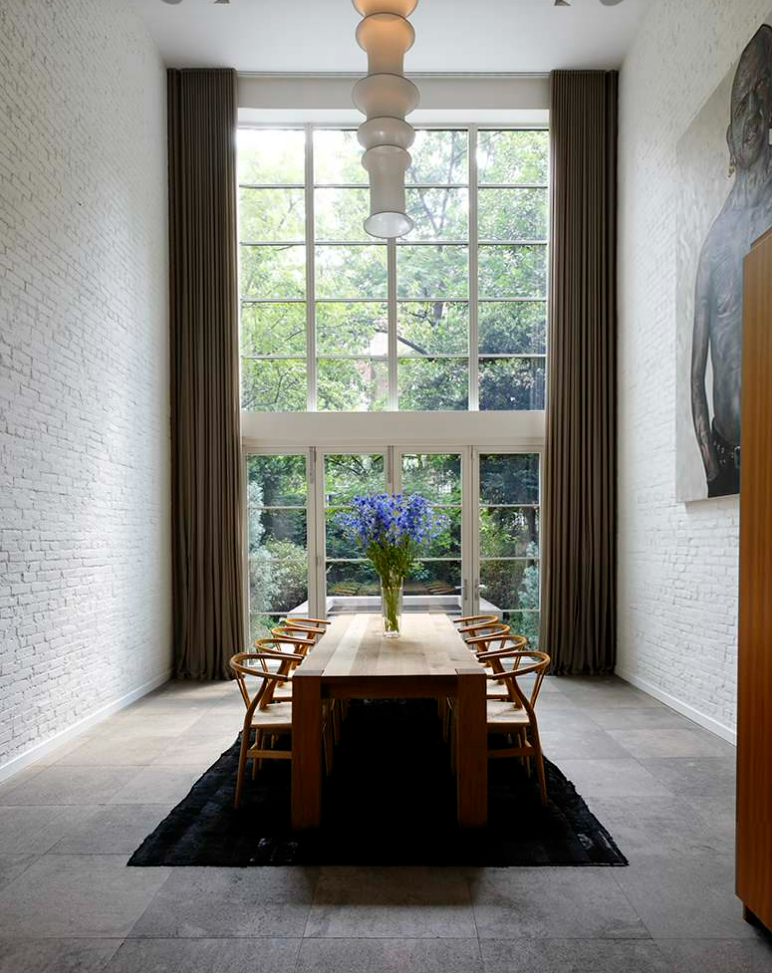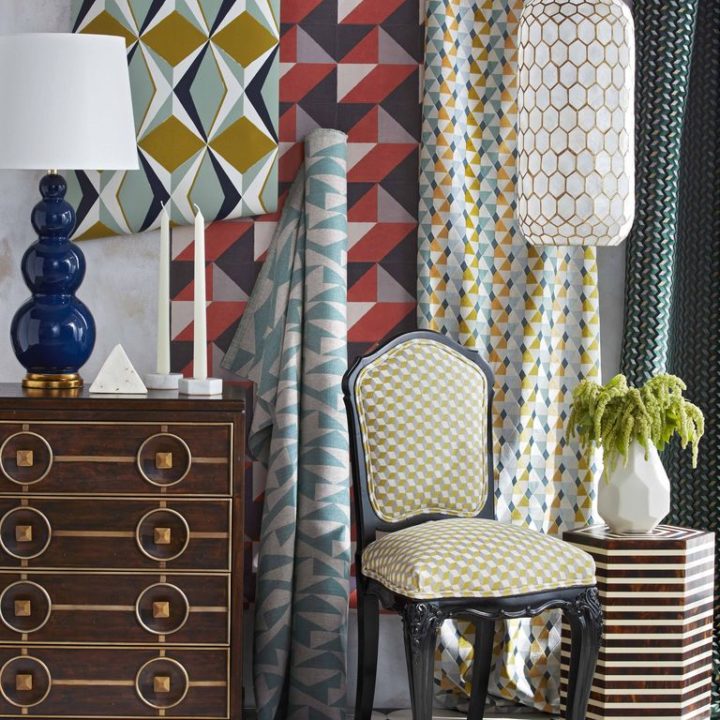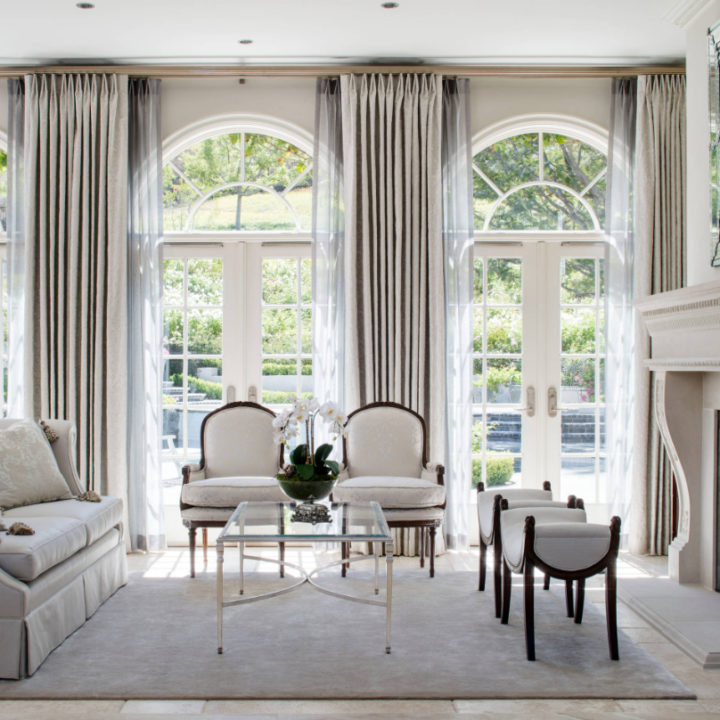Spiffy Speak
Dining Room Window Treatments: Ideas, Photos & Tips
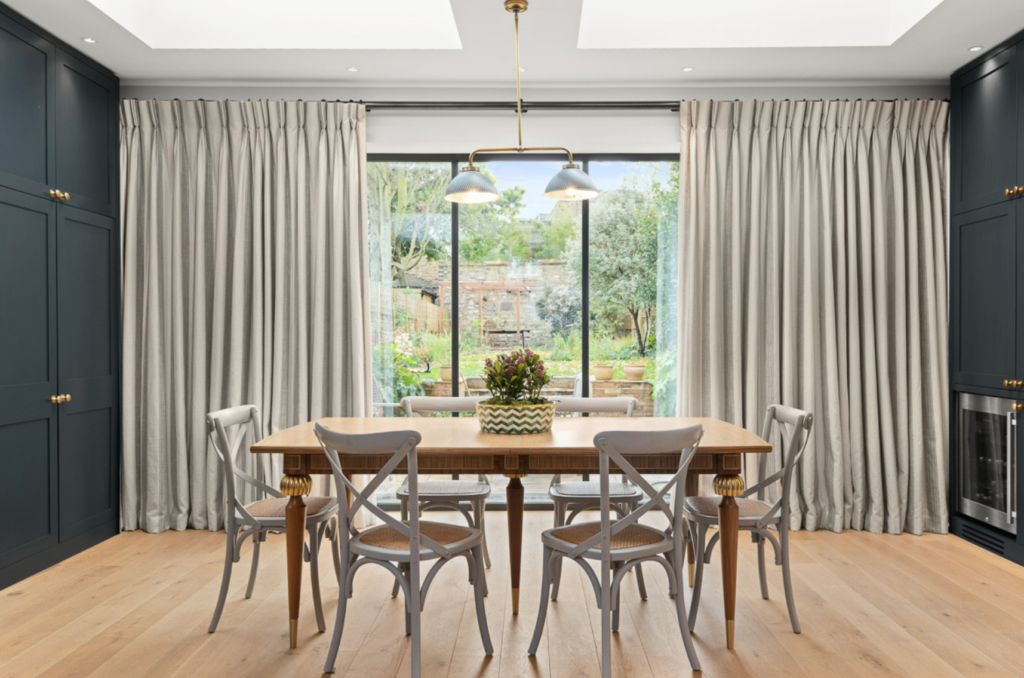
The dining room is the heart of the home where the family gathers to share meals and stories, often making this room the most lively spot in the house. This charming space, therefore, needs to be dressed in a way that is heartwarming to look at and rejuvenating to be in, and your dining room window treatments play an important role in accomplishing this goal.
Your dining room window treatments must be chosen with the aesthetic sensibility of a pâtissier without negating their practical efficiency. So to help you along, here are the top ideas and tips for dining room window treatments to dress this soulful space.
Order custom window treatments for your living room from Spiffy Spools online in any size. Pick from over 3,000 fabrics and patterns!
Recipe for Perfect Dining Room Window Treatments
Unlike some other rooms in a home, dining rooms often do not call for a high level of privacy. The functional aspect of dining room window treatments, therefore, primarily covers the ease of operability and light control.
The window treatments in your dining room must facilitate versatility in light control, effortlessly switching between light and bright to soothing candlelit dark. They should ideally also double up as an impactful decor element with their notable and elegant presence in the room.
With all that being said, the preparation of any recipe starts with an understanding of the cuisine. In your search for the perfect dining room window treatments, you first need to identify the key stylistic and functional requirements of your dining room based on the following parameters:
Fast Food Casual or Michelin Star Formal: What’s the Vibe?
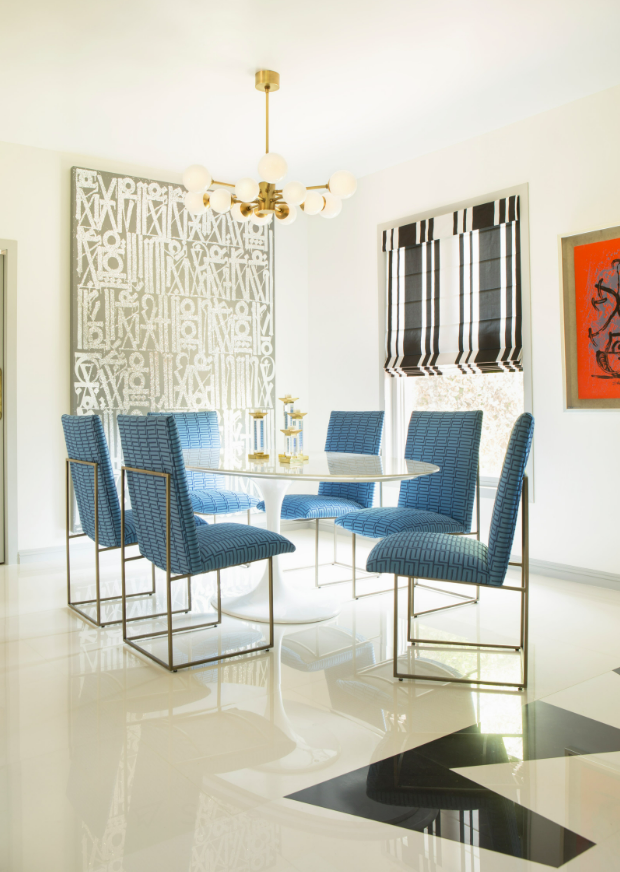
A dining room destined to host annual Christmas parties and business networking dinners often needs statement decor elements and curated embellishments to make the space feel dressed up. Such a space calls for window treatments with a formal touch, likely emphasizing looks over functionality.
On the other hand, if your dining room witnesses daily banter between siblings and close friends, it beckons a casual decor style where everyone can unwind and relax in the welcoming aura of the room. The decor elements – including your window treatments – should be laid back and highly operative as they are being placed in a room used for daily dining. The materials used should also be robust enough to withstand regular use and easy handling.
If your dining room finds itself juggling between family gossip over pizzas and hosting formal dinner parties with four-course meals, you need to find a middle ground for your window treatments. Your window coverings should not go over the top with the embellishments and yet be prepared to impress visually when a special occasion arises.
In summary, let the vibe of your dining room – formal or casual – have a say during your shopping trip for window treatments.
Bohemian Feast or Minimal Diet: What’s the Aesthetic?
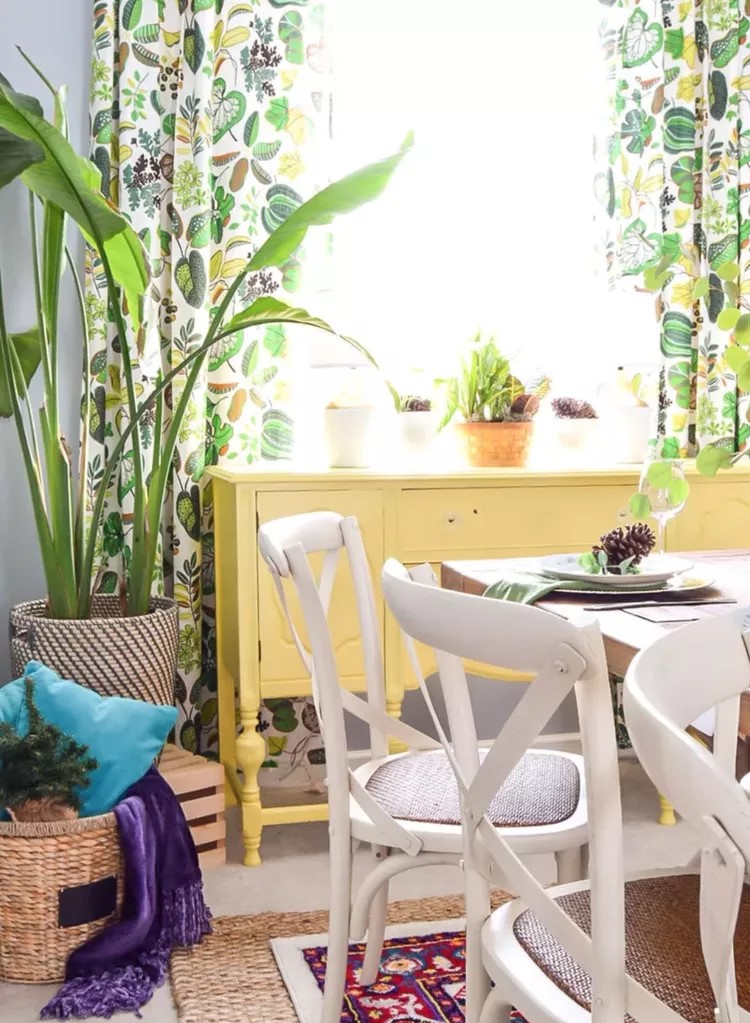
The window treatments of your dining room cannot be poles apart from the room’s overall decor. To maintain a cohesive look, dress your windows keeping in mind the decor of the room.
To give you an idea, if your room features Boho-style decor, large-scale floral and botanical patterned curtains will bring in the color and pattern-saturated look that defines Boho. In Scandinavian decor, solid nude or white-colored window treatments in natural fabrics may suit best. Similarly, country or farmhouse decor would benefit from wooden woven blinds or frilly drapes featuring checks, gingham and minuscule florals in earthy hues.
Therefore, we recommend starting by identifying the overall aesthetic of your room and picking window treatments that fall in line with the room’s decor style.
Bustling Busy or Quite Quiet: What’s Your Room’s Traffic?
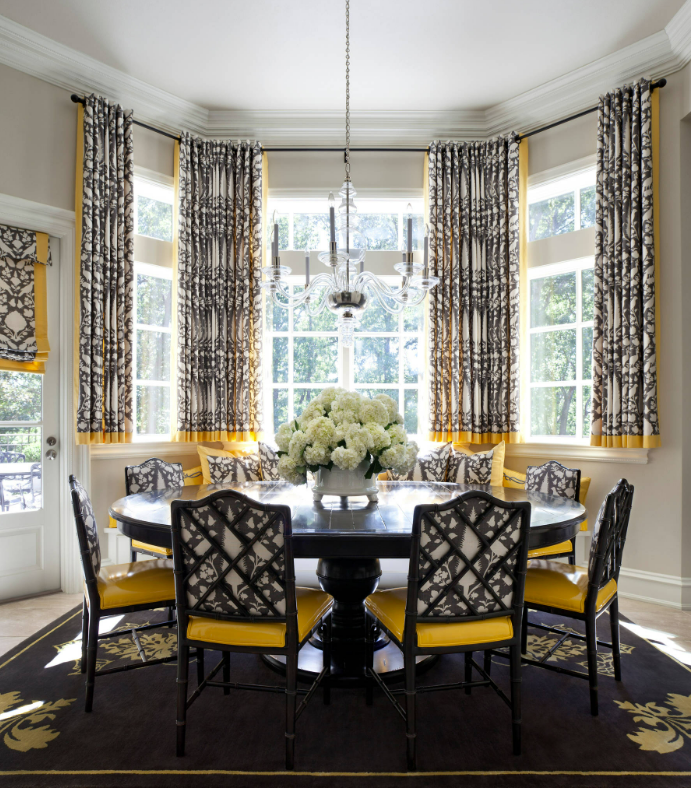
Among other factors, your dining room’s traffic also has a say in your window treatment choice. The window treatment requirements of two dining rooms with different levels of traffic will often not be the same since the priorities of the rooms, both functionally and aesthetically, are unaligned.
For example, if you have kids and pets who make a run inside the dining room every so often while playing, it may be better to go with sill-length window treatments that do not come in their beeline. Roman shades or blinds are therefore considered a safer option for homes with kids and pets.
On the other hand, if your dining room is used only for occasional events, or the footfall is low, you may consider bringing on the full drama of floor-length opulent velvet curtains, or the resplendent cascade of a pure silk roman shade.
Cozy Small or Spacious Hall: What’s the Room Size?
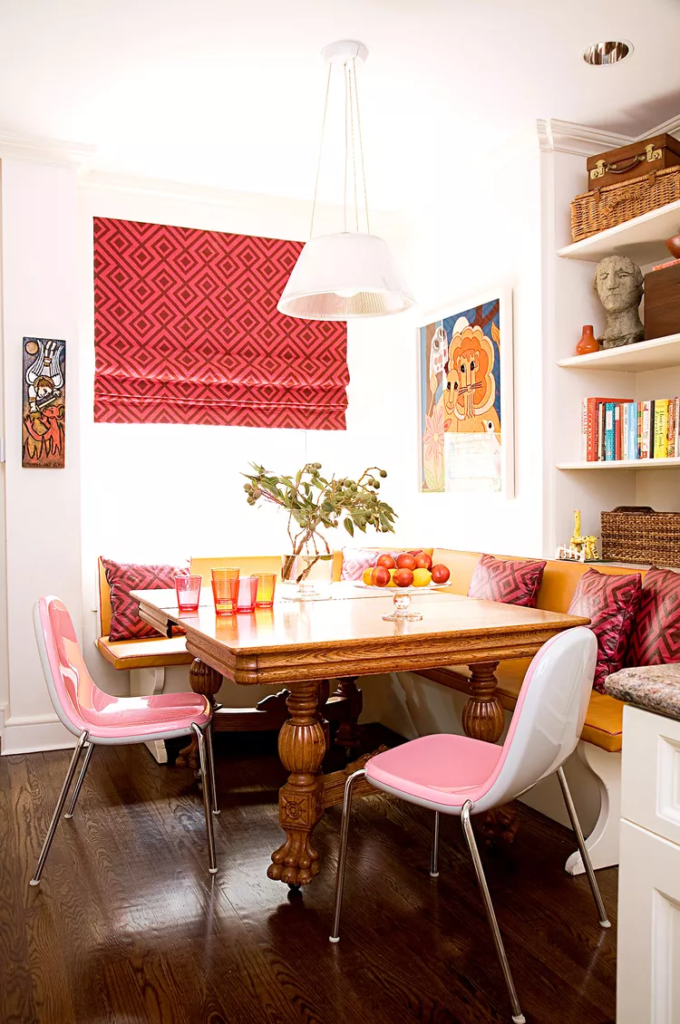
The size of your room also plays an important role in determining the perfect window treatments for your dining room.
Floor-length window dressings can be overwhelming for small windows and small rooms, for example. Therefore, if your dining room is small or features small windows, minimalist roman shades or other sill-length treatments might dress them better without clogging the space or looking cluttered to the eyes.
In a contrasting scenario, where you have the option of a large canvas, spacious room, and majestic windows, you can choose floor-length curtains that do justice to the grandeur of your space.
If for any reason – and there are plenty to be tempted by – your heart is set on roman shades, roller blinds, or other such treatments for a wide set of windows, consider having multiple narrow blinds instead of one extra-wide shade/blind for the longevity of hardware and ease of operation.
Thus, based upon the room size of your home, we hope you can further hone in your ideal window treatment, as we move on to light and privacy factors.
Well Lit or Dim Lit: Light & Privacy Requirements
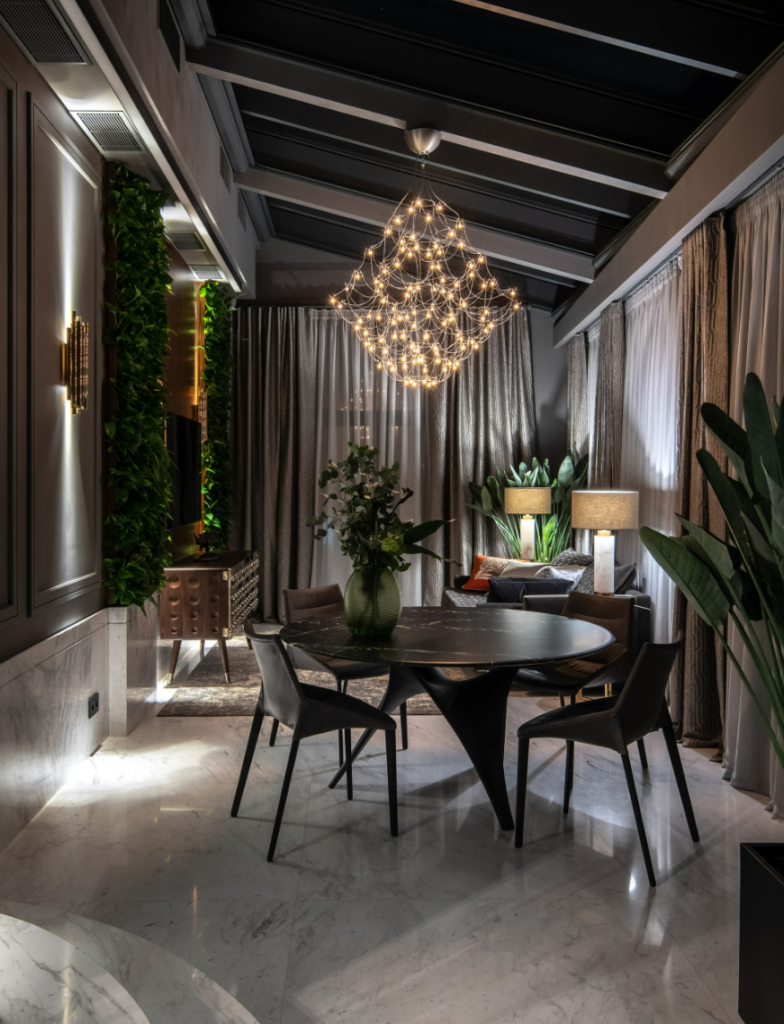
In a dining room, homeowners generally look for light control more than privacy since it is not a part of the inner sanctum of the house. This too may play a role in your choice of window treatments, their arrangement, materials, and your expenditure.
If you belong to team light, consider opting for light-colored window treatments with loose-knit fabrics or sheer materials. On the other hand, if you need window treatments designed to guard indoor tales against unwanted outdoor viewers, tight-knit fabrics or other opaque materials are your go-to solution.
If functional aspects such as light control and privacy are not high priorities, and your key goals are purely aesthetic, you may find yourself exploring options such as faux roman shades, standalone valances, or drapery panels that only frame your windows without offering full coverage, while sparing you some budget in the process.
Carefully chosen window treatments can be the perfect solution for both your light and privacy needs. Therefore, invest good thought into the light and privacy factor before you narrow down your window treatment options.
Top Three Dining Room Window Treatments
Based on all the above filters, we’re sure you have traveled a step down the designer’s funnel and narrowed down your choices. Now, it’s time to focus on your key options and pick the right window treatments to gussy up your windows. While choices abound – from traditional curtains and valances to modern cellular shades and cordless blinds – here are the top three options most loved by our own designers and stylists for a dining room.
Stealing the Beauty of Every Free Fall: Curtains & Drapes
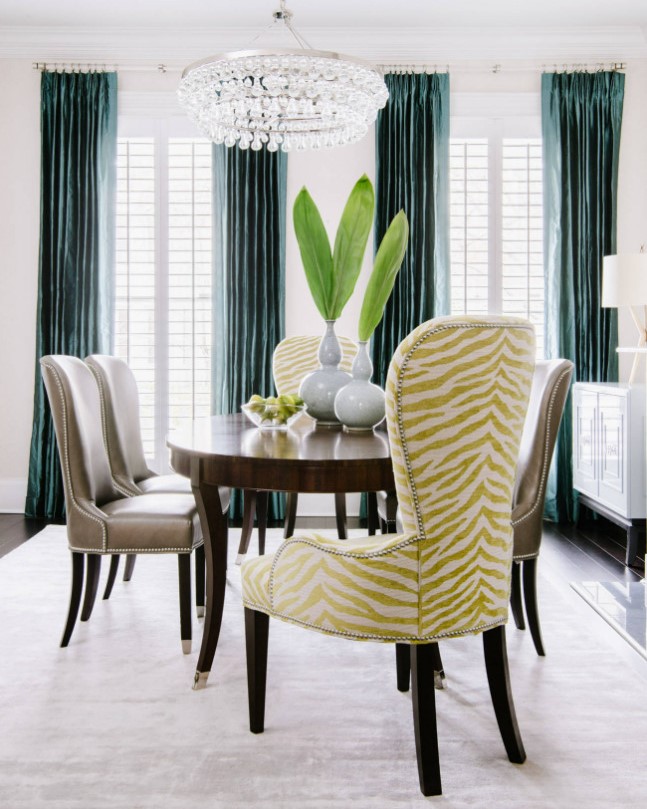
Curtains & drapes remain the indisputable favorites for most dining rooms, and we never are surprised why. Laden with the opulence of free-flowing fabric and softly rounded pleats, they bring in the much-needed va-va-voom to the most cheerful and free-spirited room of the house. No wonder these traditionally-favorite beauties are among classic window treatments, reputed for their sumptuousness and elaborate architectural qualities.
Unlike industrial options like roller blinds or wooden shades that are stark and leave no room for artistic customizations, curtains are sewn from fabrics that open up possibilities of countless palettes and patterns. This becomes a boon for home stylists who can buy custom curtains in any size, and choose from over a dozen pleating/heading styles to make them work in any setup.
At Spiffy Spools, you can go all the way and coordinate your soft furnishings like dining table covers, runners, and placemats with your curtains. That’s one spiffy dining room decor for sure!
While thoughtfully chosen curtains would suit almost any dining room, there remain certain set-ups and decor styles that especially beg for drapery over any other window treatment.
Rooms with very large windows, for example, are perfect candidates for drapes. Curtains complement and unify oversized windows with their opulence, where shades and blinds may not prove viable or sturdy.
Similarly, the copious use of fabric in curtains syncs well with the drama of maximal decor styles, making drapery the most befitting window treatment for maximal dining rooms. In fact, if you have a period dining room, your top choice is always going to be curtains that reflect the charm of the era.
It’s not just about unparalleled beauty. If you happen to have a low-ceiling dining room, you can also create an illusion of height and make the ceiling look higher by using full-length drapes, ideally featuring a vertical pattern.
With the artistic flexibility and benefits that come with choosing curtains, many a heart may already be set on them. Before you go shopping, here are the top decisions you should expect to make on your spree.
Fabric Choices
At Spiffy Spools, one is simply spoiled with choices when it comes to fabrics. So, how do you choose? As we have spoiled you indeed, we will give you some guideposts too. Here are three decisive factors you need to consider before choosing the fabric for your dining room curtains:
FABRIC COMPOSITION
Each fabric has its own nuances that pairs it best with different decor styles. Therefore, the aesthetic of your room and the functional requirements need to be considered while choosing the composition of your drapery fabric.
Formal and traditional rooms, for example, look best when dressed with silks and velvets. These plush fibers bring the luxury of manors within your dining rooms, though are better used in low-traffic dining rooms.
On the other hand, these regal piles might be too overwhelming for casual settings or smaller rooms. Natural, low-sheen fabrics with more breathability like cottons and linens, or blended fabrics are better recommendations for modern casual decors.
The fabric you use for your curtains makes or breaks the ambiance and decor of your room. So choose wisely. From earthy to modern and regal to casual, options are galore so choose wisely to suit your space.
Spiffy Tip: To increase the lifespan of your fabrics and enhance the draping ability of your curtains, we highly recommend adding lining to your curtain fabrics, especially silks.
READ MORE: SPIFFY SPOOLS LINING OPTIONS FOR CURTAINS & ROMAN SHADE
PALETTE
Where wooden shades or mass-produced roller blinds may leave you brooding upon their limited aesthetic potential, fabric window treatments such as curtains and roman shades are sure to leave you sliding through rainbows. So start with the insight that colors tell tales, and pick drapery that weaves your very own color story.
When choosing your drapery fabric, be sure to pick a palette that works with your room’s overarching decor. Once you’ve made a note of this, you can consider showcasing the primary colors on your curtains, or pick drapes in an accent hue to make them the focal point.
Also, let the size of your room have a bearing on the choice of colors. If your dining room is small, you may want to pick lighter-tone colors that blend into your walls giving an illusion of continuity and space. On the other hand, a large size dining room may seem more intimate with darker, moodier palettes.
PATTERNS
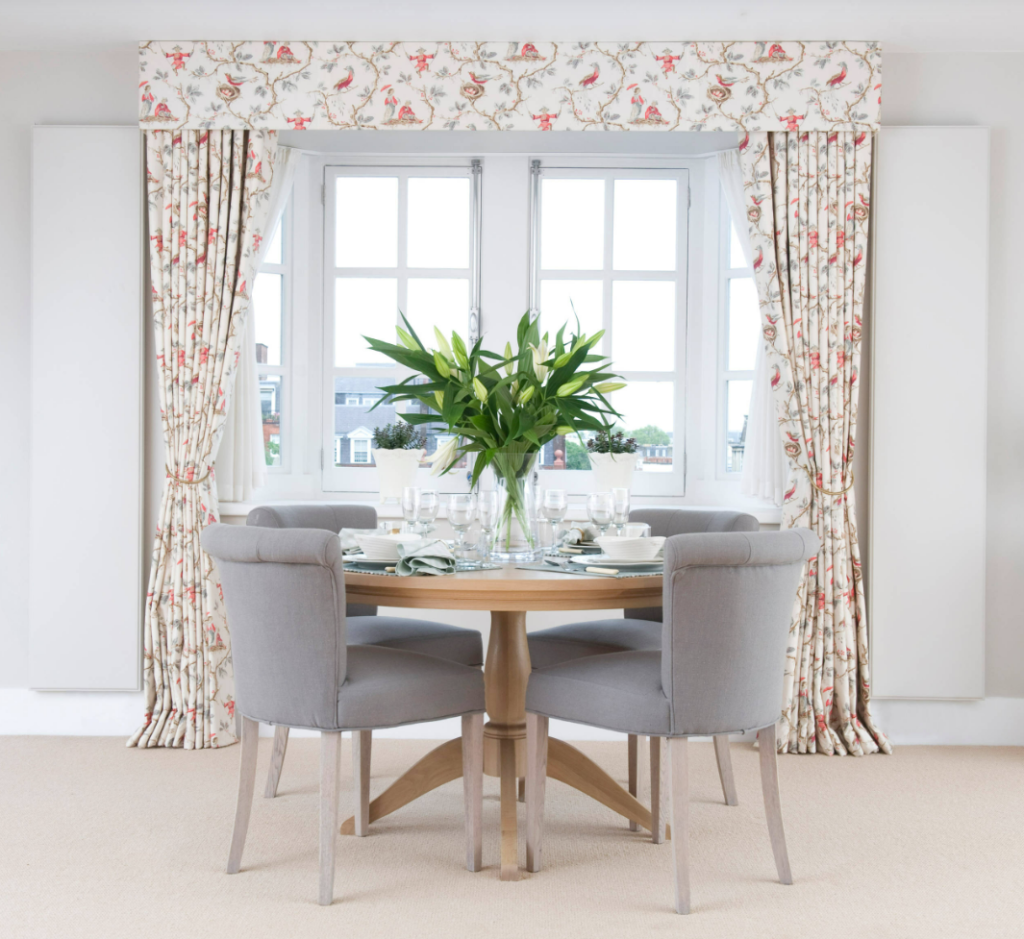
Patterns are your safety net when you feel that your dining room is looking too plain. Patterned curtains have the potential to become the art installation that your room may be missing. But before picking patterns, start by first planning out the pattern-plains ratio of your dining room. The goal is to strike a balance between patterns and plains.
Over-indulgence in plains can result in a sterile space and pattern-heaviness often causes a busy, uncomfortable ambiance. Therefore, both design elements must get their worthy platform to perform their best while complementing and accentuating the other.
So, if your dining room already engages patterns in the larger elements like the wallpaper, table runner and area rug, you might want to set it off with plain curtains. Whereas, if these are designed in plains, your dining room is desperate to have patterned drapes for the much required oomph and coziness.
Remember that any drapery patterns should mix nicely with the rest of the elements in your dining room. Classic country motifs like florals, toile, or buffalo checks hark back to pastoral lifestyle, while geometric patterns – stripes, checks, and chevrons – find their place reserved in modern homes. A maximal, classically-designed dining room will love damasks, while a boho candidate will move towards paisleys and ikats.
Another important factor to keep in mind is the size of the motifs. A small room may not be able to handle the amplified voice of large-scale motifs, and in a large room, small motifs will simply lose themselves. Therefore, choose the size of motifs acknowledging the dimension of your room and after considering whether you want the curtains to be the anchor of your room or for them to pleasantly blend in.
Curtain Heading Styles
The curtain heading style you choose is not only relevant in managing the functionality of the curtains but also plays an important aesthetic role in the overall look of your drapes.
In contemporary settings, you may favor the minimalism of flat panel and grommet tops – while a client dressing up a period dining room may instantly fall in love with goblet pinch pleats. A room with feminine undertones will benefit from rod pocket tops with delicate ruched headers, while one featuring a more masculine vibe would likely call for the boxy folds of a box pleat top.
Not just the aesthetics, the heading style also has a bearing on the functional aspect of your curtains. Curtains meant for regular use will benefit from heading styles with rings, clips, or grommets, that allow the drapes to swiftly glide across the hardware. Styles such as tab tops and rod pockets can be slightly harder to slide but remain strong candidates for drapes that are primarily decorative in dining rooms.
For a full lowdown on various heading styles, we recommend browsing our detailed Curtain Headings Style Guide before you shop.
Curtain Lengths
Another important decision to be taken is regarding the length of your curtains. If you select the best drapery fabric of the world but get the length wrong, it will be a design tragedy. Unless your design style is extremely casual or you live in a country home where cafe curtains are the staple, curtains and drapes should be floor-length to scale their highest aesthetic potential and formal appeal.
And floor-length curtains can be designed in several ways. For functional ease, you can style them to ‘float’, that is, standing an inch above the floor. Not only will the drapes glide easily on the pole, but also the bottom will be protected from getting soiled and frayed too soon. The second option is to let the curtains lightly touch the floor. The curtains will function efficiently and the look will be seamless and designer perfect.
If dining at the table is a regular practice and you prioritize function over style for this high-traffic area, one of the above described lengths should be perfect for your dining room. But if you’re looking for a touch of glamor that’s becoming of celebratory entertainment, let your drapes puddle on the floor. Again, there are many ways to achieve this chic decor style with your curtains.
The most minimalist way is to let them break-puddle, that is, extend an inch after touching the floor. The curtains will be easy to operate as compared to other elaborate styles of puddling.
If your drapes are only meant for a decorative purpose and you want to go all out on puddling them, let them extend 6-16 inches after touching the floor. Those opulent piles spell drama effortlessly – just what you’re looking for in a formal, dressy dining room. If you love the idea and want to explore more, quench your cravings in our blog post about puddled drapes.
READ MORE: SPIFFY GUIDE ON HOW TO MEASURE CURTAIN LENGTH & WIDTH
Hardware Options
Your hardware selection is no less important than your curtains. With the right hardware, your curtains will realize their full aesthetic and functional promise.
While hanging a single layer of curtains, you will need a single pole. On the other hand, for layered curtains or pole-mounted valance paired with curtains, you need double poles that can hang both.
In the event that you have opted for a heading style that will show your hardware – such as a grommet top or tab top – do put in extra care while shopping to ensure your hardware lives up to your drapes. Ornamental poles will complement traditionally-styled curtains while modern homes may prefer sleeker hardware that does not look out of place in the minimalist decor.
Spiffy Tip: If space allows, extend your hardware at least 8 inches on each side of your window frame. This will allow curtains to stack on the walls without covering windows, giving an illusion of larger windows. Furthermore, we recommend mounting the hardware as close to the ceiling as possible to draw the eye upwards and make the ceiling seem higher.
READ MORE: DINING ROOM CURTAINS & DRAPES: IDEAS & TIPS
When Curtains Met Blinds: Roman Shades
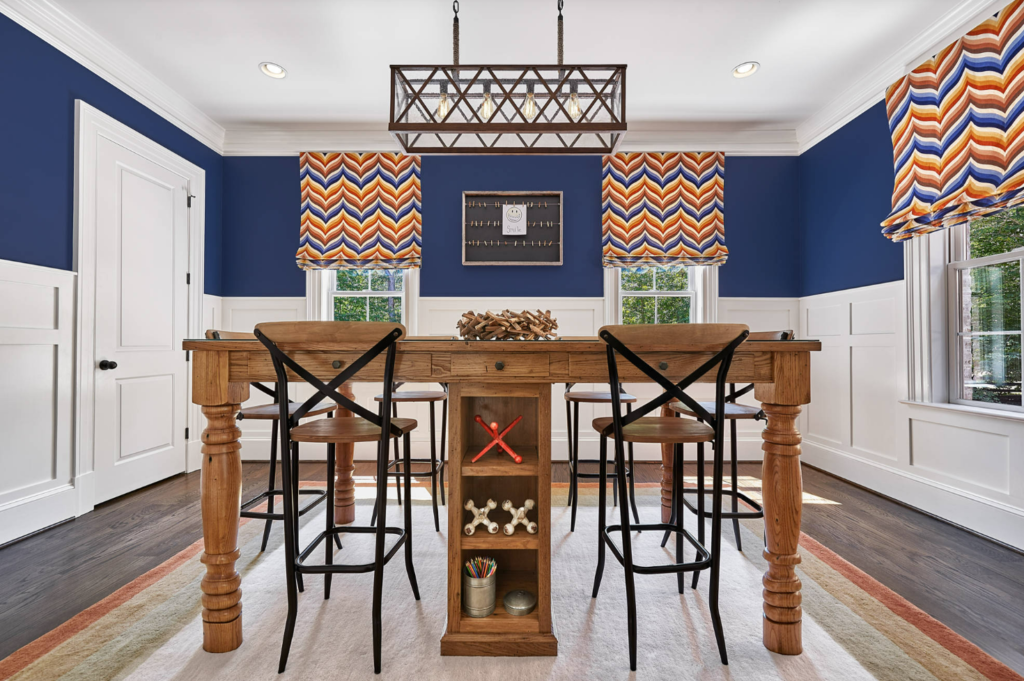
While we remain ardent fans of curtains in dining rooms, there are some situations where fabric roman shades just ‘fit’ better.
Combining the softness of drapes with the minimalism of blinds, roman shades are the perfect window treatments for spaces that cannot handle the opulence of drapes but don’t want the starkness of blinds either.
Eliminating the elaborate construct of curtains, roman shades retain all other benefits that fabric treatments come with. They bring in the much-needed hygge into dining rooms, where no matter how formal the occasion is, comfort while eating remains a must. Unlike industrial blinds that come in limited, standard forms and palettes, roman shades can be customized in several colors and patterns to add to the cheers as glasses clink and spoons swoop up smiles.
Roman shades are also undoubtedly the spiffiest window treatment solution for awkward-sized windows or small spaces. They hug your windows perfectly, just as you want them to, giving shape to your windows without making the space feel cluttered.
Furthermore, roman shades are nonpareil window treatments in high-traffic dining rooms. While curtains avow that they are not very good at handling kids running around them, roman shades can be excellent babysitters. Not that they will look after kids and pets, rather they will be heroic in preventing them from getting into nasty accidents.
To know the ins and outs of selecting the right roman shades for your dining room, let’s walk through the key styles and features.
READ MORE: WHAT ARE ROMAN SHADES: A COMPLETE GUIDE
Different Styles of Roman Shades
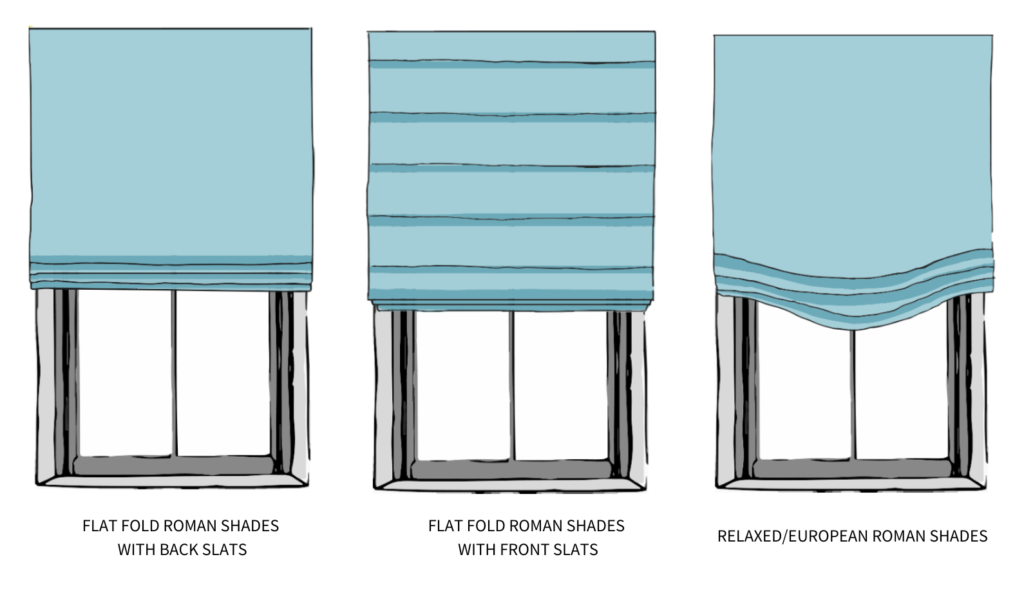
At Spiffy Spools, we offer three different styles of roman shades, each with its own nuances and niceties. Among these gems, you’re sure to find one that will meet your unique requirements:
- Flat Fold Roman Shades with Back Slats: Perfect for modern decor, minimal to their core, back slat roman shades have a clean aesthetic look while being highly functional, making them apt for daily use in formal to informal spaces.
The slats in this style are stitched into the lining at the back, thereby rendering a clean, silhouette-free frontage. Since this style allows for the pattern to be shown without any optical breaks of slats, it is the perfect style if you’ve opted for a patterned fabric for your dining room window treatments.
- Flat Fold Roman Shades with Front Slats: Sharing the highly structured and clean looks of the back slatted style along with their easy functionality, the front slatted roman shades feature visible slat silhouettes in the front.
This style is best suited for monochrome or textured fabrics since the front slats give the otherwise plain fabric an architecturally interesting visual effect.
While the style can be used in almost any setting for its high functionality and classic look, it is more suitable in semi-formal and casual dining rooms.
- European/ Relaxed Roman Shades: Gentle, elegant, and relaxed – three elements that make up European relaxed roman shades are highly favored in luxurious dining rooms. Shades in this style are structured to have an unstructured fall into a gentle scalloped curve. The luxury of these shades is their straight-out-of-a-period romance book appearance that adds a touch of exquisite fancy to your room.
Relaxed roman shades are not recommended for high-use windows since their folds often need to be set manually. But since dining room window treatments are typically not regularly operated and largely serve a visual mandate, relaxed roman shades are found gracing many a dining room.
READ MORE: ROMAN SHADE STYLE GUIDE FROM SPIFFY SPOOLS
Mounting Positions of Roman Shades
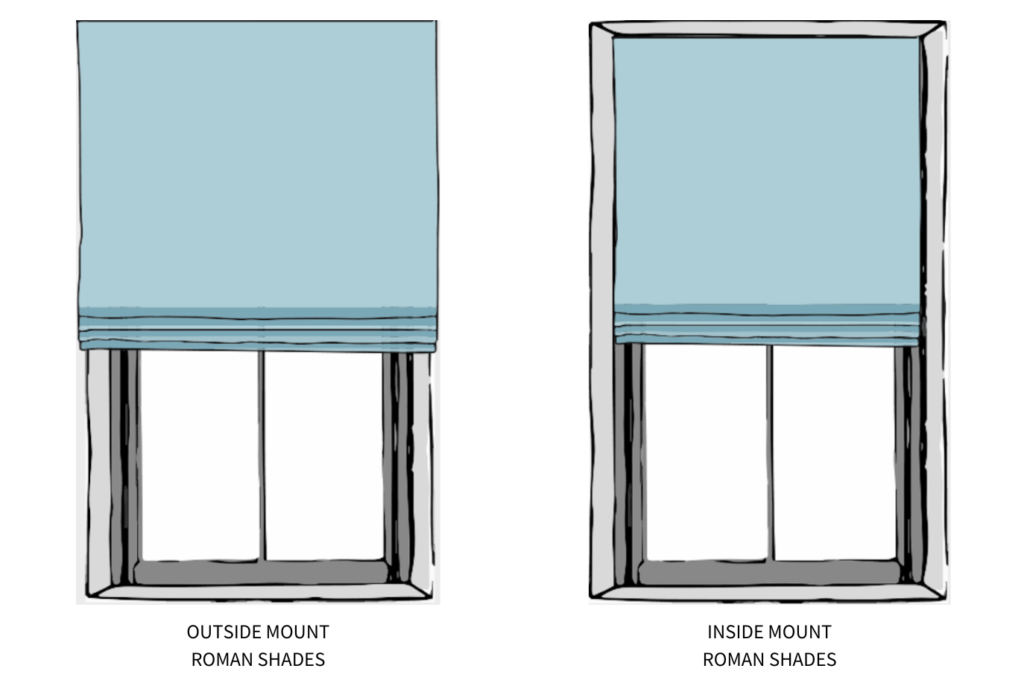
Once you know the style of roman shade you want, it is imperative that you proceed by having a clear image of the mounting position. Depending mainly on your window size and the architectural quality of the window frame, there are two mounting options to consider:
- Inside Mount Roman Shades: If your dining room showcases windows with ornate architectural work, or your window does not have much space around it, mounting your shades inside the window frame is the best option. If you are planning to layer your roman shades with curtains, this stands out as the superlative look. Do keep in mind that you need a minimum of 2 inches of space within the window recess to inside mount your roman shades from Spiffy Spools.
- Outside Mount Roman Shades: For window frames that are not deep enough to mount a shade inside, outside-mounted shades become your default choice. However, this is not the only reason clients choose this mount position. Installing shades a few inches above the frame allows the shades to clear the window completely when folded up, thereby maximizing light and air inflow. This also makes small dining room windows look larger and offers an unhindered view when the roman shades are open.
READ MORE: OUTSIDE MOUNT VS. INSIDE MOUNT ROMAN SHADES: WHAT, WHEN & WHY
Choosing the Right Fabric
Although most of the guidelines noted above for curtains also apply to roman shades, there are some other special considerations to be aware of while shopping for roman shades. Their unique structure, fold styles, and overall decor of the dining room need to be kept in mind while shopping for roman shade fabrics.
Heavy fabrics like velvets are an unlikely choice for roman shades on large sized windows because their dense naps and excess weight may make them cumbersome to operate. Also, unless you choose to back the shades with lining, be discrete with the choice of lightweight fabrics as they may not hold to the structure of the shade with refinement.
If you have decided to get front-slatted shades, solid fabrics are going to be your top choice since the slats provide an architectural element of interest to an otherwise plain roman shade. On the other hand, back-slatted and relaxed roman shades have a flat surface which gives space for patterns to shine.
A subtle enchantment for any dining room roman shades may come in the form of accessories. In minimalist decors, the sublime beauty of ribbon trims is unmatchable while maximalist dining rooms can easily sway along with colorful tassels or pom-pom trims.
The fabric selection is a crucial factor that defines the overall look of your roman shades and the dining room. Therefore, before making your choice, look at all the factors that make a difference.
READ MORE: BEST ROMAN SHADES FOR DINING ROOM: IDEAS & TIPS
Here for the Show: Valances & Faux Shades
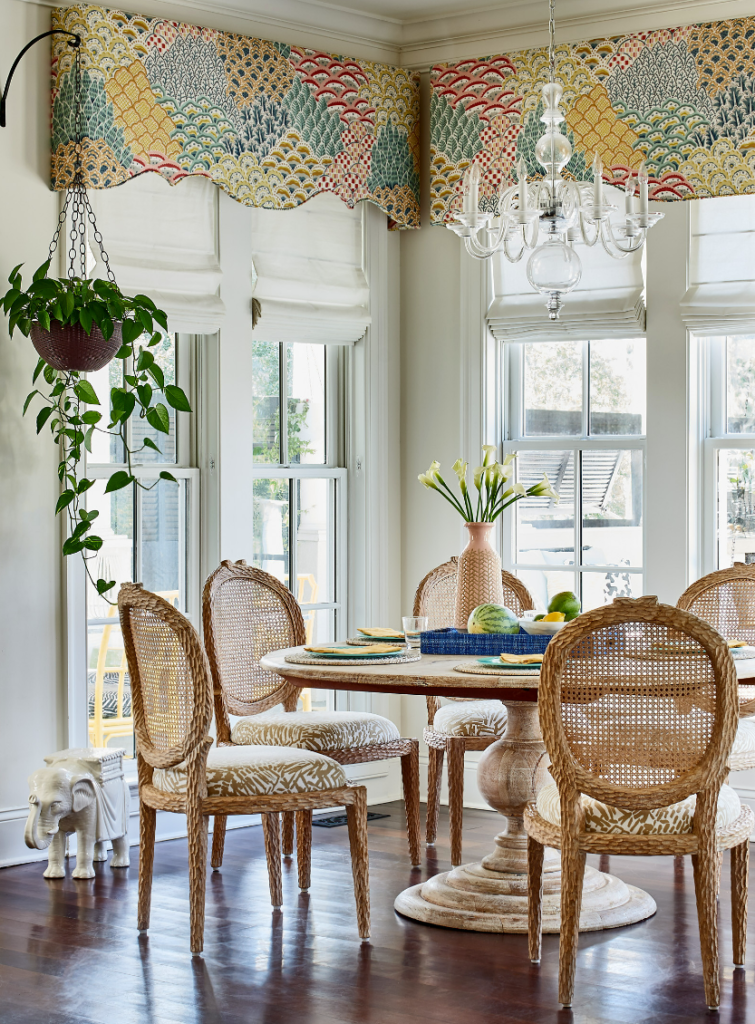
Valance and faux shades are here for the show!
Used primarily as decorative accessories, valances and faux shades do not offer the same level of functional benefits as other window treatments. They are, however, your safe spots to get creative and experiment with colors and patterns.
For dining rooms where clients would prefer to leave their windows undressed to let in full light and view, valances are the perfect candidates to soften the look without taking away anything from the windows.
They can also be used as an overtreatment with other window treatments to give the window decor a finesse. In this role, they help in hiding the undertreatment’s hardware and sport a cleaner look. Adding valances or faux roman shades also helps elongate the space vertically by drawing the eyes upwards. This works like a magic trick in opening up smaller dining rooms.
Lastly, being a fabric treatment, they let you bring in a sense of organic warmth that brightens up the space. A dining room does not find good friends among non-fabric treatments that do not offer a charming and welcoming hug to their visual audience. If you want to bring in the love of fabric in minimal tones and optical real estate, valances or faux roman shades are your winning candidates.
Look-Alike Roman Shades: Faux Shades
If you just want to keep the look of roman shades without their functional aspect and maintenance cost, you are looking for faux shades. Stealing the style of roman shades, faux shades give you their aesthetic while being a cheaper alternative.
They look like drawn-up shades and do not move up and down. Being a static fixture, they also come with a longer shelf-life. They are easier to install, simply by the use of a curtain pole or tension rod. Thus, it becomes a quick fix if you are making an emergency purchase while moving houses or if you often change your home.
Like roman shades, you can also accessorize your faux shades with tassels and trims to add an element of visual interest to your window treatment that you are getting just for their show. In a casual setting, you can add the playful pom-poms and for a formal room, you can go for ribbon trims in any of our traditional motifs.
SHOP NOW: CUSTOM FAKE/FAUX ROMAN SHADE VALANCE FROM SPIFFY SPOOLS
The Cherry on Top: Valances
Just as a tiered cake always seems incomplete without a cherry on top, valances are that element that complete window treatments. While minimalists may think that cherry is not their thing, the varied options of valances available at Spiffy Spools surprise every stylist with their capability to seamlessly blend into all styles of decor, from maximal to minimal and every in between.
At Spiffy Spools, you will find two main mounting styles of valances – board-mounted and pole-mounted valances. Board-mounted valances come with all necessary hardware and feature a more structured look, befitting for formal rooms. Pole-mounted valances have a relatively casual air to them. These come with rod pockets on top and are simply slid onto the poles, like rod pocket drapes.
Under each of the mounting methods, you will find valances of various types – flat-frontaged, pleated, gathered, and opulent swags. Whatever be the style of valance, ensure that they sync with your decor style. And, keep these tips in mind so you can make the most of them:
- Firstly, be careful with the scaling of the motifs on patterned valances. These petite decor accessories cannot feature grand-sized motifs without them getting cut off abruptly.
- Let the fabric dictate the choice of your valance style. If you’ve selected a patterned fabric, choose a valance with a flat frontage so they can display their colors and shapes impressively. Whereas, a plain fabric looks elevated in pleated, gathered or swag styles which highlight the opulent folds and careful construction of pleats befittingly.
- If your valances are overtreatments, make sure they complement the primary treatments with their palette, pattern and design.
SHOP NOW: CUSTOM WINDOW VALANCES & SWAGS FROM SPIFFY SPOOLS
A Word on Layering Window Treatments in Dining Room
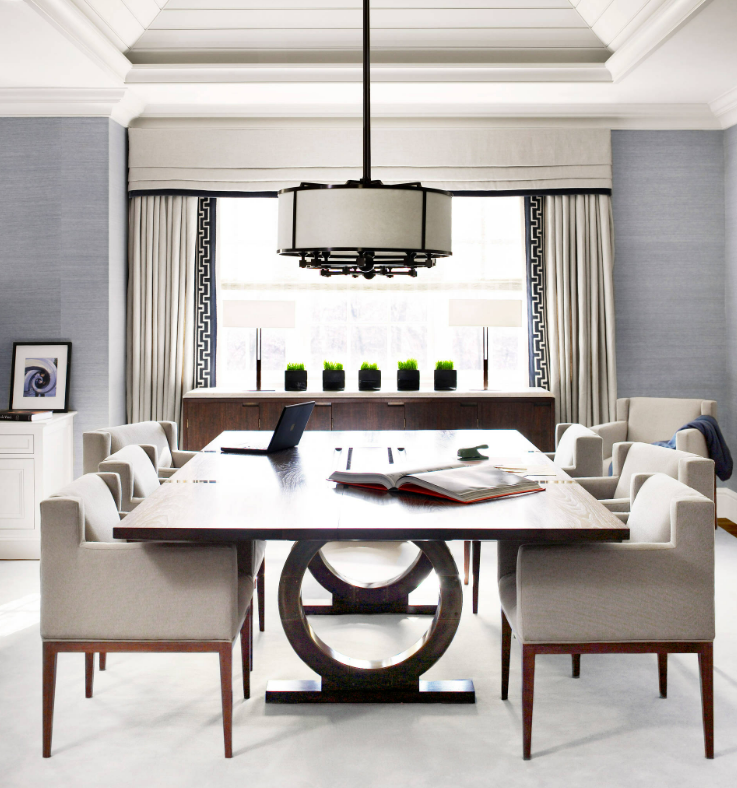
While you can go for standalone treatments in your home, there is nothing as good as layered window treatments. Not only do each of the window treatments that you use enhance each other’s looks, but also add to their functional flexibility.
Layering window treatments also helps you in adding different fabrics that serve alternative purposes. For example, you can add sheer roman shades that operate vertically to increase or diffuse light inflow and blackout curtains to switch to a dark and moody atmosphere.
As mentioned earlier, topping all your treatments with valances helps in completing your window decor. If there are multiple windows in your dining room that are dressed with different treatments or are varied in size, valances can also bring a sense of cohesive flow among your windows and their decor.
Therefore, depending upon your requirements, or even just for purely aesthetic purposes, layering your window treatments is always a win-win deal.
READ MORE: HOW TO LAYER ROMAN SHADES WITH CURTAINS
In Closing
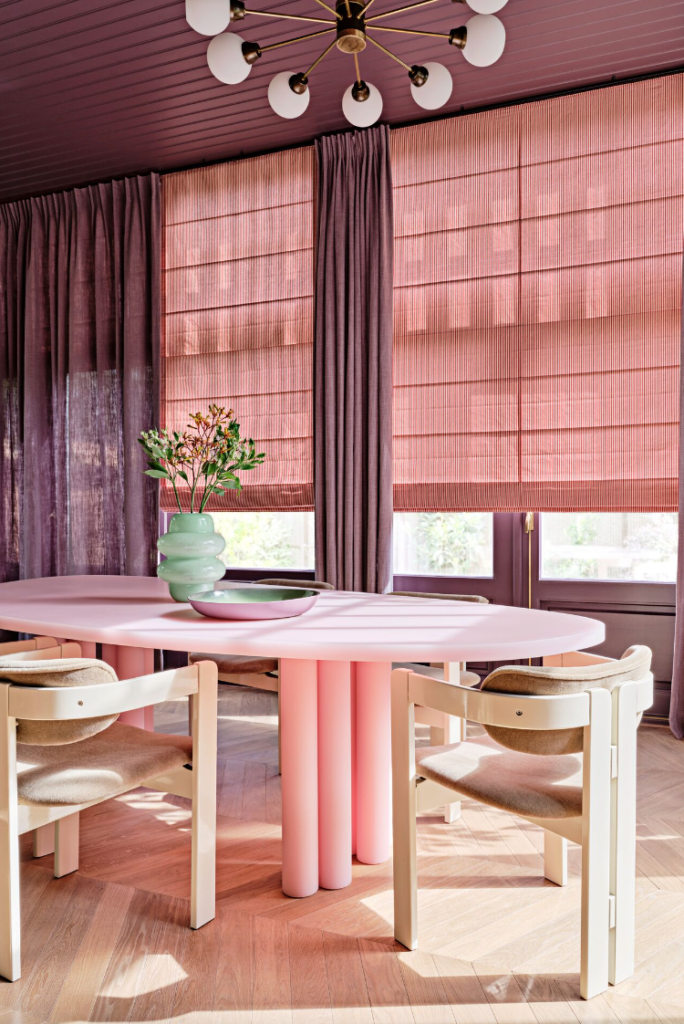
While you could indeed go for any other window treatment based on your requirements, our designers recommend these three fabric window treatments because the dining room is meant to be a space where you add softer elements to make it inviting and warm.
For example, if you are looking for the stark edginess of industrial modern decor, you can go for blinds. However, it is worth mentioning that while the sleekness of blinds remains uncontested, their aesthetic value is limited.
Whether it is for formal gatherings or everyday meals over everyday banter, it’s the special moments that give a dining room its purpose. This space, therefore, deserves the best of decor because it is with food and our close people that we get to be truly happy.
Your window treatments walk the longest way in telling how much effort has been given to the decoration of your home. Whether you are choosing one element, or carefully layering them and coordinating them with other elements in your room, it will all make a statement on what a pro designer you are. Just like cooking is an art, let your windows be a canvas too. Paint as you like, impress your loved ones, and treat every eye as much as you treat your tastebuds with tasteful window treatments.
Order Custom Window Treatments from Spiffy Spools
All done with the learning but let’s not stop here. Take us along on your dining room window treatments shopping spree. You can weave your happy hours while we weave your perfect window treatments. Shop now and create spools of memories with Spiffy Spools!
READ MORE: MODERN DINING ROOM DÉCOR IDEAS

